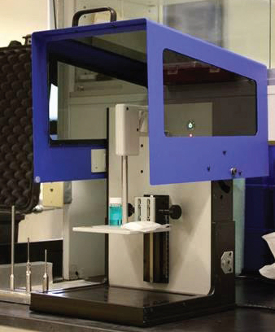Featured Article

Most undergraduate chemistry departments do not have Raman spectroscopy instruments in their instructional laboratories. Cost is a primary reason—a Raman spectrometer is typically in the $100,000 range. The fragility of research Raman instruments is another factor, i.e., they were not designed for the rigors of a hands-on teaching environment and often require frequent calibration and component replacement. When they break, replacement parts become an issue.
 Figure 1 – The TouchRaman MOMO has an open design to enable collaboration of several students using Raman spectroscopy. This design is also compatible with bringing large samples to the height-adjustable assay stage. The outer cover protects users from stray laser light.
Figure 1 – The TouchRaman MOMO has an open design to enable collaboration of several students using Raman spectroscopy. This design is also compatible with bringing large samples to the height-adjustable assay stage. The outer cover protects users from stray laser light.“Raman has been tough to teach, especially at the undergraduate level,” said S. Michael Angel, Professor, Department of Chemistry and Biochemistry, University of South Carolina (Columbia). “Today’s commercial systems are complex and too fragile for use in the classroom. And, most … budgets can’t [accommodate] the purchase price.”
To address this challenge, MarqMetrix (Seattle, Wash.) and Hellma USA (Plainview, N.Y.) partnered to bring an educational instrument and curriculum to colleges and universities to offer training in Raman spectroscopy skills to the next generation of scientists.
The TouchRaman BallProbe MOMO (Figure 1), developed by MarqMetrix and designed specifically for the educational environment, incorporates a safe way to operate a laser in a durable, open package, and is offered at about a third of the price of a traditional Raman spectrometer. Hellma developed the curriculum, which is used for teaching the basics in conjunction with the instruments. All of the components of a Raman spectroscopy system are integrated into one complete teaching platform.
The sample stage can be manually raised so that the sample touches the patented spherical-ball lens of the TouchRaman BallProbe mounted in the MOMO device. Liquid samples can be immersed (Figure 2). The Raman spectrum (Figure 3) records the intensity of light emitted as a function of the wavelength. Intensity is proportional to the concentration.
 Figure 3 – Typical Raman spectrum obtained from the TouchRaman BallProbe. Key features are the intensity and wavelength of the peak, creating a molecular fingerprint of the sample. Raman spectra record signals related to whole molecule vibrations, which are often complementary to those observed in infrared spectroscopy.
Figure 3 – Typical Raman spectrum obtained from the TouchRaman BallProbe. Key features are the intensity and wavelength of the peak, creating a molecular fingerprint of the sample. Raman spectra record signals related to whole molecule vibrations, which are often complementary to those observed in infrared spectroscopy. Figure 2 – Close-up of the height-adjustable BallProbe sample stage. The lower end of the vertical probe end is terminated with a high-purity sapphire ball lens. Laser light is transmitted to the ball by a metal encased light pipe (center). Light passes through the patented spherical lens and into the sample region immediately below the sapphire ball. In this case, a solid pill is located immediately under the BallProbe; the probe is equally effective with liquids, slurries and powders. When a sample is excited using a laser, Stokes (Raman) scattering occurs. Part of the Stokes scattered light reenters the sapphire ball and up the optics to the detector where the intensity is recorded as a function of wavelength, yielding a Raman spectrum.
Figure 2 – Close-up of the height-adjustable BallProbe sample stage. The lower end of the vertical probe end is terminated with a high-purity sapphire ball lens. Laser light is transmitted to the ball by a metal encased light pipe (center). Light passes through the patented spherical lens and into the sample region immediately below the sapphire ball. In this case, a solid pill is located immediately under the BallProbe; the probe is equally effective with liquids, slurries and powders. When a sample is excited using a laser, Stokes (Raman) scattering occurs. Part of the Stokes scattered light reenters the sapphire ball and up the optics to the detector where the intensity is recorded as a function of wavelength, yielding a Raman spectrum.This workstation makes Raman accessible, providing a simple interface so that students can immediately start measuring and interpreting the data and applying the results, as opposed to learning how to use the instrumentation. In effect, the chemist or scientist can practice his or her trade without having to become a spectroscopist.
Raman technology more advanced than ever
To facilitate measurement using Raman spectroscopy, the TouchRaman BallProbe features ease of sampling, i.e., touch the sample and take the measurement; simple operation, nondestructive reproducible sampling; and real-time, high-information data output. In continuous processing monitoring, the ability to obtain real-time, highly reliable in situ data during the manufacturing process creates enormous time efficiencies, improves quality control and mitigates waste. Simplifed instrumentation and sampling offered by the TouchRaman BallProbe place the focus on data and analysis. Highly reliable data, in turn, improves the process and quality of the product.
TouchRaman BallProbe applications
- Gas blending analysis in the oil and petrochemical industries
- Manufacture of active pharmaceutical ingredients, fostered by the FDA
- Monitoring of carotenoids and lipids in live farmed salmon
- Measurement of sulfur content in diesel fuel
- Quality control in the polymer industry, i.e., ensuring the correct formulation of a polymer blend
- Determination of protein composition in foods
- Identification of cancerous tissue, which can be done in real time during a surgical procedure.
Brian Marquardt is CEO/CTO, and Giora Proskurowski is manager of the Raman Division, MarqMetrix, 2157 North Northlake Way, Ste. 240, Seattle, Wash. 98103, U.S.A.; tel.: 206-971-3625; e-mail: [email protected]; www.marqmetrix.com